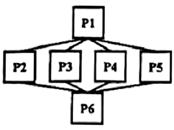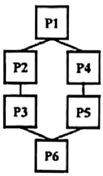1 . In one of the more unusual experiments we’ve seen recently, researchers attached a large pair of cartoonish huge eyes to the front of a small, self-driving vehicle—and it turns out that this kind of adaptation could actually improve pedestrian (行人) safety.
A pair of eyes on the front of driverless vehicles could, according to the researchers, give people standing by the road a better idea of whether they’ve been seen. That’s one useful bit of information to have when it comes to determining the perfect moment to cross in front of oncoming traffic. “If the car is not looking at the pedestrian, this implies that the car does not recognize the pedestrian,” said one of the researchers. “Thus, pedestrians can judge that they should not cross the street, thereby avoiding potential traffic accidents.”
For the purposes of this study, the researchers used a car which seemed as if no one was inside. A pair of large, swiveling (旋转的) eyes on the front were controlled by researchers, but in the future could be controlled by the car’s AI on an actual self-driving vehicle.
To keep the 18 participants safe, experiments were conducted in virtual reality. The volunteers—nine men and nine women—were asked to decide whether or not to cross the road as the car approached. Four scenarios(方案) were tested in total; two when the car was fitted with eyes, and two when it wasn’t. The researchers measured how often people hesitated to cross when it was in fact safe to do so, and how often they chose to cross when it was dangerous. Overall, the presence of the eyes led to safer and smoother crossing experiences for the participants.
However, there was a gender split in the results. For men, the eyes only really helped in dangerous situations, warning them to pause when they might otherwise proceed. For women, the eyes boosted confidence by signaling it was safe to cross.
1. What is the function of cartoonish huge eyes?| A.Improving the safety of self-driving vehicles. |
| B.Helping people decide when to cross the road. |
| C.Keeping pedestrians in a complete safe state. |
| D.Promoting the appearance of self-driving vehicles. |
| A.There was a robot in the car. |
| B.The pair of large eyes were controlled by AI. |
| C.The experiments were designed by 18 volunteers. |
| D.Experiments weren’t conducted in real surroundings. |
| A.Doubtful. | B.Objective. | C.Negative. | D.Positive. |
| A.To advertise a new self-driving technology. |
| B.To enhance pedestrians’ awareness of safety. |
| C.To inform us of a new research on driverless vehicles. |
| D.To introduce the influence of a new type of car. |
2 . One of the most important changes cities must make to improve life in them is to separate people from their cars. Even when you have a strong public transport system in moving people between population hubs, the last mile - that section between the railway station and someone’s home, for example - can lead to car use if it’s considered too far or too dangerous to walk.
The idea of a low-traffic neighbourhood (LTN) - where cars are banned from quieter ‘rat runs’ (偏僻小路) to keep them on the major routes - has taken off in parts of the UK. LTNs attempt to filter out cars from residential streets using bollards, camera-controlled gates or even planters full of flowers placed across the road, while pedestrians, cyclists and emergency vehicles can still pass.
Analysis for the active transport charity Sustrans found that “driving a mile on a minor urban road is twice as likely to kill or seriously injure a child pedestrian, and three times more likely to kill or seriously injure a child cyclist, compared to driving a mile on an urban A-road,” and that heavy car traffic in residential areas can lead to a rise in social isolation. LTNs reduce this danger, leading to a three-fold reduction in injuries, and have been shown to increase the number of visitors to local businesses.
Also popular are e-scooter hire trials, which are taking place in towns and cities including Middlesbrough, Bristol and Chelmsford. The trials see gaggles of electric scooters available to be picked up from street corners. The scooters are hired using an app and then, once they’re finished with, parked elsewhere inside the trial area, where they’re collected and recharged by the hiring company. A Department of Transport report on e-scooter use found they were “widely perceived to have environmental and convenience benefits,” but suffered from comparisons to children’s toys.
But that’s not all. The world’s first hub for demonstrating electric air taxis and drones opened in Coventry earlier this year. The taxis and drones based at the hub all take off and land vertically like helicopters and are being used to travel short journeys or deliver cargo.
Weaning us off our car addiction is one of the more difficult barriers standing between us and healthier cities. The first step that needs to be taken will be to tackle the dominance of the car.
1. What can we learn from Paragraph 1?| A.People are considered reliant on cars to travel. |
| B.Public transport system still needs improvement. |
| C.Pollution from cars has an impact on people’s life quality. |
| D.Residential areas are usually far away from the railway station. |
| A.It’s a way to encourage social interaction and local business. |
| B.It’s a series of measures to reserve the streets to walking residents. |
| C.It’s a system that employs high technology to keep cars on the main roads. |
| D.It’s a practice proved effective in keeping children safe from traffic accidents. |
P=Paragraph
A. | B. |
C. | D. |
| A.To call on readers to construct a healthier city. |
| B.To promote the latest developments in car alternatives. |
| C.To introduce possible ways to get rid of dependence on cars. |
| D.To inform citizens of technological advances to tackle social problems. |



